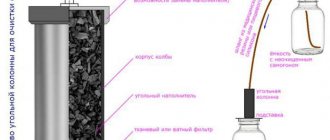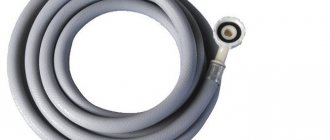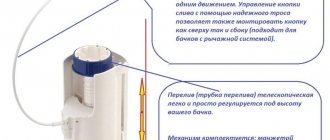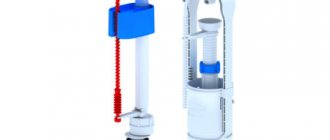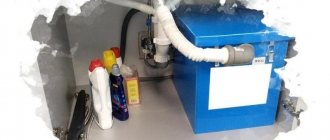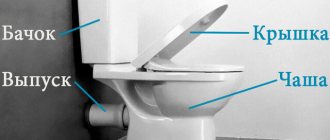High technologies penetrate into all spheres of human life. Plumbing was no exception: equipping kitchens and bathrooms with electronic innovations has already become not just a tribute to fashion, but a reasonable solution for increasing convenience and saving valuable natural resources. A sensor water faucet is one of these technological “helpers” that allows you to save money and optimize daily household processes.
Features of touch taps
Everyone knows the type of standard faucet and its control elements - a pair of rotating knobs or a ball regulator. But at first glance, a touch faucet can cause bewilderment and misunderstanding of how to use it, because there is no usual flow control here.
A sensor faucet is an automatic water faucet without valves. All actions with it are carried out using photocells, IR, induction and ultrasonic sensors. They detect the presence of foreign objects (human hands) in the coverage area and turn the water on or off. Sensors can be included in the crane structure or supplied separately as a cover.
Each smart faucet has a sensitivity zone. Its parameters may vary, but on average it is about 25 centimeters.
The temperature is mainly regulated by levers or a rotary valve, but among expensive samples there are automatic ones with a touch strip. Some “smart” faucets are also equipped with a control panel, which can be used to regulate pressure and temperature from a distance.
Interesting: the hand sensors are made in such a way that they do not react to random objects entering the area of action. So, if you spill shampoo or knock over soap on the work surface, the automatic touchless faucet is not activated, since it must respond solely to the movement of human palms or the container being brought.
Possible problems during operation
After installing the touch tap, problems may arise during operation:
- changing the coverage area of infrared radiation;
- clogging of the aerator with rust;
- decrease in sensor sensitivity.
Problem solving
If the touch sensor fails, it is not recommended to carry out repairs yourself. In most cases, problems arise due to a clogged aerator, so it is better to contact a professional technician. If the jet pressure has decreased, then this is a sign of a malfunction and only a specialist knows how the touch mixer works in order to replace the old aerator with a new analogue. To adjust the IR radiation coverage area, you need to check the cleanliness of the electronic unit screen, the sensor display and make new settings.
Where are they used?
Plumbing fixtures with touch controls can now increasingly be found in bathrooms/toilet rooms and kitchens of apartments, private homes and offices. In addition, water taps with an IR sensor for opening water and other varieties use:
- in many cafes and restaurants;
- in the areas of shopping centers and supermarkets;
- in hospitals and clinics;
- in cinemas;
- in other public places and spaces.
Additional functions
The final price of the mixer may be influenced by additional functions that are designed to ensure more comfortable use of the product and water procedures. We will list only the most common of them.
Adjustment.
Some sensor faucets do not have the ability to adjust the pressure, the sensitivity of the IR sensor, the shutdown time after use, or all of these functions together. Models without such functions have factory settings that cannot be changed.
Silence.
When turning on and off, the water supply mechanism may make a soft clicking sound. If such little things are important to you, then you can spend a little time looking for a sensor faucet with silent operation.
Design and principles of operation
Let's look at the design of a touchless faucet using the example of a mixer with a built-in induction sensor. This element generates a magnetic field determined by the system settings and changes its value when human hands appear in the field of vision.
The functional part of the automatic mixer consists of:
- head control unit;
- the above-mentioned induction sensor;
- actuator unit - solenoid valve;
- check valve to prevent backflow.
The sensor creates a magnetic field determined by the device parameters. When an object enters the latter’s area, the sensor sends a command to the control unit. He, in turn, turns on the valve and opens the water. When the command stops (the signal is gone), the valve closes and stops flow.
The solenoid element consists of:
- actually, the solenoid coil;
- mixer membranes;
- gadget core tubes;
- shielding coil;
- saddles;
- seals;
- housings;
- structure retainer;
- tips;
- springs and core.
How does an automatic touchless faucet work:
- when a signal is supplied from the sensor, the magnetic field acts on the tap core;
- he rises;
- the membrane rises with it, and the water opens.
As you can see, the gadget needs electricity to work. Its supply is provided in two ways:
- from the home network;
- Autonomous, from batteries/accumulators.
There are various faucet models that support the first or second power supply (or both). The wall-powered sensor for the washbasin, kitchen or bathroom does not require battery replacement; you can simply install it, plug it in and forget it. But it is necessary to think about the installation location so that it is located near the source of electricity, or install another outlet nearby. A battery-powered automatic water mixer does not have this drawback; in addition, it is safer and works even when the lights in the house are turned off. But this is compensated by periodically replacing the batteries.
Pros and cons of touch faucets
This category of touch-controlled devices has undeniable advantages over conventional mechanical ones:
- comfort and convenience. The tap is easier to operate, it does not have handles that can be screwed too tightly and then have to force to open;
- maintaining hygiene: if your hands are dirty, to start the water you just need to bring them to the sensor without touching the tap itself. This is especially important in public places visited by many people every day (restrooms in cafes, restaurants, restrooms), where plumbing fixtures tend to collect many microorganisms, including pathogens. A touchless faucet effectively solves this problem;
- An automatic touchless faucet saves water—and the owner’s money. If a person’s hands are not under the tap, water does not flow, which means the readings on the meter do not increase;
- you don’t have to worry about accidentally turning off the tap;
- Quite a few models support setting the desired temperature, so even young children can safely use such a smart mixer without fear of getting burned or hypothermic;
- As a rule, touchless faucets look very stylish and modernize the interior;
- some advanced models with automated water supply can be integrated into the “smart home” ecosystem. They can be given a command from a smartphone, for example, to fill a bathtub while in another room or even on the way to the house, and control the temperature and volume of liquid supplied in real time.
Of course, in the case of remote filling of the bath, you need to control the volume poured and know exactly how much it holds, or equip it with a water level sensor to avoid flooding.
But there are also disadvantages due to the specifics of the device:
- inconvenient to use if you need to change the temperature frequently. For example, this is not very comfortable in the kitchen, where you usually need either hot or cold water, and the automatic tap is configured only to support a certain mode. The settings will have to be constantly changed;
- The sensor faucet for the sink is also inconvenient in situations where large vessels and bathtubs are regularly filled. You will have to continuously keep your hands on the sensor; you cannot move away from the tap. This drawback is partially compensated for in models with sensor disabling (as well as overlays with this function);
- relatively high cost, which may make the mixer unaffordable for purchase. This situation is also partly corrected by much cheaper pads;
- dependence on home electricity or batteries. Without power, the touchless faucet is non-functional;
- If the faucet is equipped with a photocell sensor, there is a chance of false alarms due to glare of light. Infrared or ultrasonic options do not have this disadvantage.
Advantages and disadvantages
Although touch-sensitive faucets are found in a wide range on the plumbing fixtures market, their widespread use in households is hampered by a number of limiting factors. Touch taps, unlike conventional plumbing fixtures, have the following features:
- Their cost is much higher and ranges from several to tens of thousands of rubles.
- Manufacturers of touchless faucets indicate that their water-saving appliances save about 33% of water.
- A touchless kitchen faucet has an advantage when preparing food with dirty products - by bringing too dirty hands to the sensor, you can wash them without touching the levers or valve handles.
- The touchless touchless sink faucet outperforms its competitors in terms of hygiene - no hand contact is required to turn it on and off.
- Due to the lack of user contact, a touch-sensitive basin faucet requires less maintenance than a standard single-lever or two-handle faucet.
- Many expensive high-tech models of touchless faucets are equipped with electronic thermostatic regulators - this allows you to set the temperature conditions of their operation using a remote control.
- Unlike traditional household faucets, contactless devices require electricity to operate, which is supplied in two ways - through a 220 V AC to DC converter, or using 4 AA batteries with a total voltage of 6 V.
Rice. 4 Faucets with built-in control panel
- To power the mixer from an alternating current network, it is necessary to install a separate electrical line and install an outlet under the sink to connect the power cord, and these are additional costs.
- With normal use of the touch faucet, the batteries last for approximately 1 - 2 months, after which you need to buy new elements - this leads to additional waste of funds.
- If the batteries are low, the touch tap is locked and cannot be used.
- The continuous operation time of most bathtub faucets is limited by factory settings and does not exceed 1 minute.
- Unlike cartridge faucets, touch faucets are strictly divided into kitchen faucets and washbasin faucets; with the help of the latter, it is unlikely that you will be able to wash dishes in the kitchen.
- The advantage of modern touchless faucets is their aesthetic appearance; many models go well with the high-tech style of the kitchen.
- If you use a touch faucet with an infrared sensor on a bathroom sink to wash your hands, it will be inconvenient to brush your teeth or rinse your face - the water will constantly turn off. It is also impossible to fill the washbasin without the presence of hands in the sensor area. To use the faucet in the sink for some time without raising your palms, you can set the shutdown delay not 0.5 seconds, but more, but you won’t have to talk about any water savings.
- Some simple models of mixers do not provide for flow regulation, because the solenoid valve only completely opens and closes the channel.
- When using contactless models, many users complain about noticeable hydraulic shocks in the line - the water suddenly turns on with maximum pressure. In many cases, owners are forced to install a pressure reducer.
- Non-contact models are more sensitive to dirt in water than cartridge models and require the installation of a coarse water filter.
Rice. 5 Standard mixer equipment
- A little-known disadvantage of designs with solenoid shut-off valves is the mixing of hot and cold water in the main. The fact is that, unlike a cartridge, where the connection of water flows occurs in its body after lifting the lever, the magnetic valve allows already mixed water to pass through, which has been in the pipes for a long time. To combat this drawback, check valves are installed in the pipeline up to the tap, which is an additional expense.
- Touchless taps are set to a certain temperature, and when a cheap model does not have an automatic thermostat, the water will always be colder at the beginning of use and for comfort it will have to be drained for some time - this is how all savings are lost.
- The lowest water consumption combined with ease of use is possible when using a contact touch model with instantaneous shutdown of the water supply at the user’s discretion, but it is significantly more expensive than a standard cartridge faucet.
- When using contactless infrared faucets, problems arise with filling large volumes of water - you must constantly keep your hands near the sensor. It’s hard to imagine how to fill a bathtub with water using a touchless touch faucet.
- Any sensor faucet without an external regulator is inconvenient to use when you need to constantly change the water temperature. If in a cartridge this can be done with one lever, then in a touch model, an additional tap installed on the side of the body or under the sink is used to adjust the temperature.
- The best application for touchless faucets is washbasins in public sanitary facilities, where visitors only wash their hands. In addition to being hygienic, taps can significantly save water when there are a large number of people, when many people forget to turn it off.
Rice. 6 Solenoid valve design
Types of automatic cranes
By purpose it is customary to distinguish:
- kitchen faucet/bathroom fixture with touchless sensor and U-shaped or swivel spout;
- built-in and external models for urinals;
- sensor faucet on the toilet. He starts serving with a delay of about 5 seconds and does it for 10-15 seconds.
Classification by control method:
- with push-button touch sensor. They are controlled via a touch panel, with its help you can use the faucet functions and change settings;
- contactless, not involving manipulation of the panel. On certain models you can set individual lighting themes and customize them in other ways.
Classification according to the length of the water jet:
- long - over 35 centimeters;
- with an average jet - 20–35 centimeters;
- shortened versions.
By mobility:
- fixed monolithic;
- with a rotating design.
It also highlights designer faucets made according to an individual plan.
Types of cranes according to operating principles:
- devices with separate taps;
- more complex single-lever options;
- with double spout;
- electronic.
Separate ones are the simplest. This device is a smart mixer with two separately adjustable taps from the hot/cold water supply. They have reliable electronic and mechanical components, are inexpensive and can be adjusted once to a comfortable temperature.
Among the single-lever types there are:
- ceramic type;
- spherical design.
The output flow is controlled by a single lever with a ceramic or ball cartridge built-in. Ceramics are more resistant to mechanical wear, but at the same time, they are sensitive to the composition of water. And the ball part wears out relatively quickly.
The design with a double spout is close to single-lever ones and is, in fact, their modification. The key difference is the presence of an integrated water filter in the system. Such mixers provide the ability to switch from direct water flow to a filter and back.
An electronic faucet with a sensor is the most complex. These models include many functions, for example:
- automatic control of water pressure and temperature;
- setting memory operation modes for several sets of parameters;
- remote access, and so on.
They also include a remote control point. The gadgets are aesthetically pleasing and fit well into interiors.
The disadvantage of such models is their high cost and difficulty in repairing; it is difficult to repair such a mixer in the event of a malfunction. Therefore, they are still not very popular in Russia.
There is also a division according to the work program:
- non-contact mixer with continuous flow. This plumbing supplies water to a person from the moment movement is detected by the sensor until it stops;
- automatic touch with periodic spout. These faucets detect movement, turn on the flow for a set number of seconds, and shut off.
Classification by sensor type was discussed at the beginning of the review. Mixers with an infrared sensor and ultrasonic ones are more reliable, since the photocell, as already mentioned, has a chance of false positives when light reflections fall on the working surface.
There is also a separate subtype of smart faucets - attachments for standard mechanical ones.
Touch attachments
As the name suggests, these devices are mounted on a simple water tap.
Their operating principle is simple:
- the nozzle is installed;
- water opens;
- Until the infrared (or other) sensor is triggered, the device is in standby mode and acts as a passive plug, opening the water only when the sensor is activated.
These gadgets fit almost any home faucet, run on batteries and allow you to turn even an old Soviet faucet into an automated one. There are options with different functionality - adjusting the response delay, jet output time, and so on. The disadvantage of this solution is that the temperature and pressure still have to be adjusted manually.
Manufacturers claim long battery life. For example, attachments from the Xiaomi product line can work for up to six months without recharging. They usually have an infrared or induction sensor.
What are touchless thermostatic taps?
Touchless faucets with thermostat are the most expensive models on the market. Such taps not only turn on automatically when detecting movement, but also maintain the set water temperature, even if there is a large difference in pressure in the pipes.
You can obtain more detailed information about these wonderful products from consultants at specialized construction and online stores.
Did you find this article helpful? Please share it on social networks: Don't forget to bookmark the Nedvio website. We talk about construction, renovation, and country real estate in an interesting, useful and understandable way.
How to choose a touch faucet
To choose the right “smart” plumbing, you need to focus on the following points:
- It is advisable to choose models with a sensitivity adjustment function. This will allow you to flexibly configure the tap according to the owner’s preferences;
- It is better that the purchased mixer with a sensor has additional functions - turning off the flow by timeout, frequency of turning on and off, etc. The more of them, the more convenient it will be to use the device (but it will also cost more);
- presence of temperature control;
- if you plan to create a “smart home” complex, a device with a motion sensor must be able to be integrated into a home automation system.
You should also consider:
- body material;
- presence/absence of a remote control or control via an application;
- jet length;
- mixer dimensions;
- a set of additional functions;
- type of power supply - from an outlet or autonomous. This parameter is critically important, since it largely determines the installation location;
- type of sensor (faucet with an infrared sensor, ultrasonic model, or another).
When choosing a faucet, you should pay attention to its system - one- or two-pipe. If you plan to supply both hot and cold water, the choice should be made on a two-pipe scheme. We must not forget about the aesthetic side of the issue: for example, in a room with another faucet already installed, it is advisable to choose an automatic one that matches it in style.
Popular brands
When choosing the model you like, pay attention to the reviews of the manufacturer. The following brands have proven themselves well on the market:
Kopfgescheit - Austrian faucets with infrared sensors made of bronze with the ability to configure the sensor response zone and turn it off using the remote control. The operating temperature of the mixer is 1 - 45 ° C, the response time delay is 0.5 s, the sensor coverage area is 25 cm (factory settings), the operating pressure is from 0.5 to 7 bar. The warranty period for Kopfgescheit (Smart Head) products is 5 years.
Lemark are Russian-made Czech brand faucets, made of stainless steel and brass, equipped with ceramic shut-off cartridges, capable of withstanding pressure up to 9 atmospheres. The high quality of the product is indicated by the warranty period of 4 years from the date of purchase.
Frap is a Russian brand of sanitary ware manufactured in China, characterized by an optimal price-quality ratio, as evidenced by two main product lines - Standard and Lux. The product is produced using Italian technology, as a result of which the outer surface of the taps is perfectly smooth. There are faucets available in the market in a variety of colors.
Frap touch models contain shutdown timers and electronic thermostats; their standard operating temperature threshold is 38 °C. For budget faucets, the warranty period for cartridges and locking elements is 1 year, and the body is guaranteed for 5 years.
Gappo - Chinese faucets produced using German technology have been known on the Russian market since 2002. The brand belongs to the largest manufacturer of sanitary equipment - the Haiba concern. The products are distinguished by perfectly smooth ceramic cartridges and a special design of aerators that make the flow light and airy, and the use of high-quality Spanish Hens and Sedal cartridges significantly increases the service life of the equipment. Budget faucets are produced in a wide range of stylistic solutions, various shapes, colors and models, the warranty period established by the manufacturer is 5 years.
Rice. 10 Cost of brands Grohe, Gappo
Grohe - products from the world famous German company are sold in more than 130 countries. Its distinctive features are German quality and, accordingly, a service life of up to 30 years, stylish design, technical excellence using cutting-edge technologies. The mixers are easy and reliable to install, convenient to use, and Grohe products have a warranty period of 5 years. Like all European plumbing fixtures, Grohe taps cannot be classified as budget products; their cost compared to analogues is much higher, which is compensated by the above advantages.
Among German companies supplying their plumbing products to the domestic market, brands such as Himark, Hansgrohe, Axor, Kludi, Blanco are less well known.
Oras is a brand of the Oras Group from Finland, whose history began in 1945. Its subsidiary is the German company Hansa; in addition to Finland, factories are located in the Czech Republic, Poland and Germany. Oras touchless faucets are equipped with a unique development of the company - a highly sensitive Oras Autofocus sensor.
Oras faucets are made from chrome-plated brass alloy by seamless casting, can withstand high pressure loads, and their flexible hoses feature a left-hand thread. When aerating, air bubbles are added to the water, which makes the flow smoother and reduces water consumption. Unlike its European counterparts, the cost of Oras is more affordable; all products have a warranty period of 5 years.
Rice. 11 Price and appearance of mixers Oras, Ksitex, VitrA, Varion Armaturen
Ksitex is a domestic manufacturer of various equipment and technology for toilets and bathrooms. It produces about a dozen contactless models of automatic faucets costing from 6,000 to 9,000 rubles. The devices can withstand pressure up to 7 atmospheres, operate in a temperature range from 1 to 60 °C with a water flow of about 10 liters per minute. The factory setting of the sensor at 16 cm can be changed automatically; depending on the model, the solenoid valve is located outside in a separate block or inside the device body.
VitrA is a Turkish brand owned by a company that is part of Turkey's largest holding company Eczacibasia. There are about 40 more companies under his patronage. The holding's enterprises, with an annual turnover of $3.2 billion, employ over 10,000 employees. Eczacibasia owns German companies: Engers (manufacturer of ceramic tiles) and Burgbad, a European leader in the production of furniture for sanitary facilities and bathrooms.
The VitrA line of touchless faucets is called AquaSee, the taps are connected to cold and hot water with two connections, the solenoid valve is located inside chrome-plated brass bodies. The VitrA line of touchless faucets has few models, and you can’t call them budget ones either - the cost of a regular faucet with an infrared sensor is about 17,000 rubles.
Varion Armaturen - despite the formidable German name, faucets under this brand are produced by a production and trading association from St. Petersburg. In collaboration with the Finnish company Variosan OY, the company has developed and produced advanced plumbing fixtures using components from their world-famous companies: DiLorenzo (Italy), Fluhs (Germany), Valfsel (Turkey), Neoperl (Germany), Aere Plast (Italy), Vernet (France), KCG (Taiwan). The range of Varion sensor mixers is not too wide; the average cost of a typical model is about 11,000 rubles.
Rice. 12 Basic operations when installing a tap with internal mixing
Faucet installation
Let's consider the main stages of the device installation process.
Installation of a sensor mixer takes place in two main stages:
- placement of the gadget body, control unit;
- connecting it to water pipes.
Important: before starting work, be sure to turn off the water supply!
The first step is to dismantle the mixer to be replaced, if there is one. As a rule, installation is carried out in the designated mounting hole in the sink. A special gasket is placed between it and the “smart” plumbing fixture, usually included in the delivery kit. If you don't have it, you need to buy this consumable.
The bottom of the tap is placed on a gasket with plates and secured with the supplied nut. All fasteners are usually included in the box. Next, the mixer control box is installed.
Important: there must be at least 55 cm from the box to the floor! The touchless faucet is connected to the box with a flexible hose.
Next, you need to supply water to the device. For this purpose, the nipples are connected to the water pipes, and a gasket is placed at the junction of the control box and the smart faucet.
The key element of a plumbing gadget is the solenoid valve. For its correct operation, the solenoid is connected to the control unit via a wire (to do this, it is usually necessary to remove the bolted housing cover). Batteries are also installed there (if the device is autonomous).
When everything is connected and the batteries, if any, are placed, you can assemble the unit, turn on the water and check the faucet for functionality. The principle of installing bath/shower taps is generally similar, with the exception of the features of wall mounting.
Design elements
Almost all contact and non-contact touch mixers have the same design structure, which includes the following components:
- Frame . It is made of bronze, brass, or less often stainless steel, with a spout placed on it and auxiliary components built in - a touch, optoelectronic or infrared sensor, an electromagnetic valve (in some models).
- An electronic control unit is a board with electronic elements that can be placed either in the mixer body or in a separate unit.
- Solenoid valve . All mixers can be divided into two groups - the first valve is placed in the body of the device and directly shuts off the water in it; two hoses with hot and cold water are connected to it. In other designs, the valve is placed in a separate mixing block, to which hot and cold water is supplied, and one flexible hose is connected to the tap.
In some models of sensor faucets, three flexible hoses are connected to the body: one with mixed water and two for supplying only cold or hot water.
The solenoid electromagnetic valve (Fig. 6) works according to the following principle - when electric current is applied to the winding of the coil, the metal core located inside it is drawn inward, and the membrane valve connected to it opens the passage hole in the seat - water flows through the mixer channel into the ebb. In the absence of voltage, the channel is closed by the valve due to the spring pressing the core to the passage hole.
- Power unit . A regular mixer is powered by 4 standard AA batteries or a power supply, which is a 220 V to DC (6 or 9 V) mains voltage converter; often the devices are equipped with two types of power.
- Water filter . To increase the service life of the mixer, many appliances are equipped with additional coarse filters to remove sand and large fractions, which are placed under the sink.
- Flexible eyeliner . The water supply hoses are included, on one side they have an external thread with rubber rings for connection to the mixer, the second is equipped with American-type threaded fittings.
Rice. 7 Roca tap design with integrated solenoid valve
Faucet repair
In simple cases, minor independent repairs or diagnostics are possible. Let's look at some common situations:
- There is no water shutoff. With such a malfunction, most likely the membrane is clogged. The mixer should be disassembled and the membrane should be cleaned of scale and dirt particles.
- Failures, false positives. These symptoms indicate a sensor malfunction; it needs to be checked and, if possible, replaced.
- Accidental operation of a faucet powered by photocells. Most likely, this situation is due to glare from light sources. The light flux can be reflected from the sink and affect the sensor. The solution is to remove the disturbing excess lighting.
Interestingly, in rare cases, the infrared sensor also detects visible light.
Do I need a specific sink for a touchless faucet?
No. Any will do. Moreover, you first need to choose a sink, and only then select a mixer for it. If the product is too short and small, water may flow down the wall of the washbasin and flood it; in addition, with a short tap it will be inconvenient to wash your hands.
On the contrary, taps that are too long will direct the flow of water towards the front wall of the sink, causing water to splash. It is optimal for the water jet to be in the middle or slightly behind the center of the sink.
Sink faucets may also be sold with spray kits - a handheld shower head with a point holder or on a rod. There are also touchless thermostatic taps.
Is it worth buying a sensor faucet?
Plumbing fixtures from this family help solve many problems:
- Ease of use;
- safety of family members and home;
- automation of daily actions;
- remote monitoring and control;
- combating unsanitary conditions in public premises, protecting them from leaks.
The “smart faucet” will be relevant for all lovers of new products and just people who want to equip their home/commercial premises with the latest technology. It's comfortable, stylish and practical. But you should take into account the nuances of use - for example, where you often need to adjust the water temperature and switch between cold and hot, a touch tap may become inconvenient. It will also not be suitable in cases where you need to draw a lot of water - after all, something must “keep” the sensor in action for this time, which means you will have to constantly keep your hands nearby. But this problem can be solved by purchasing a flexibly configurable model with the ability to temporarily turn off.
It is important to clearly define the location of the tap (kitchen, bathroom) and its tasks. The choice of device model and type depends on this. A bathtub faucet is not suitable for a kitchen, and vice versa, and in brightly lit areas it is better to provide an infrared option.
If you don’t want to spend time and effort installing a full-fledged mixer, it makes sense to pay attention to sensor attachments. This will cost much less and allow you to enjoy almost all the benefits of touch control of water.
Alternative option
The disadvantages of touch taps described above are tolerable, but undesirable. So that the housewife does not have to experience inconvenience with the supply of water and its temperature, American craftsmen offer alternatives to touch taps - touch nozzles. These attachments operate in a similar way to taps, but they are attached to the gander itself, screwing into the thread. The advantages of such a nozzle are obvious:
- by easily dismantling the nozzle, you can get a faucet that is familiar in everyday life;
- the price of nozzles is significantly lower than that of taps;
- the nozzle operates using conventional batteries;
- many models have the same functional settings as the faucet;
- The attachment allows you to completely disable the sensor function.
Touch nozzle
The only thing that can stop you from purchasing an nozzle is the appearance of the faucet after its installation. Often the attachments look a little rough, as they do not fit into the overall style of the room. However, with most of the positive characteristics of this device, many housewives neglect aesthetics, choosing, first of all, saving the family budget. And this is an important advantage of water supply devices - real benefits and savings.


